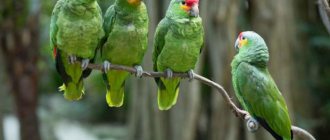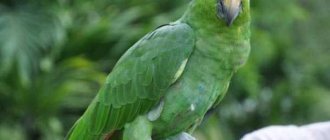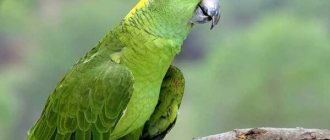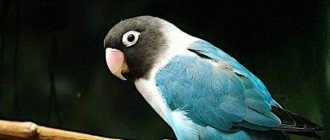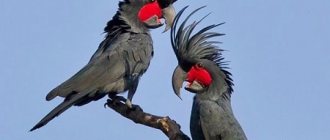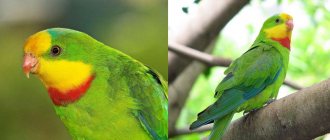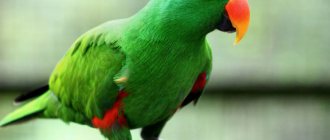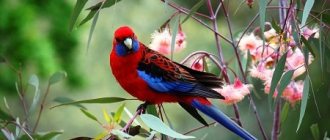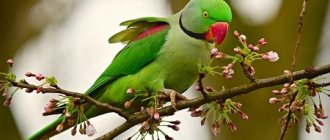Appearance
- The multi-colored bird, size 31-34, belongs to large breeds.
- The tail of the Venezuelan parrot reaches up to 9 cm.
- The weight of an adult bird is 350 grams.
- The pet's head has mostly yellow feathers.
- The bird's forehead is decorated with blue plumage, the legs are dark brown, the feathers are green in color with a red stripe along the edges; when straightened in flight, a beautiful pattern appears.
- The area near the pet's eyes is gray-blue.
- The iris of the bird's eyes remains gray for up to three years, then changes to an orange tint.
- The beak is small, yellow-brown, with a dark color at the tip; rounded
Information
They are looking for places to create a family hearth in hollows. The clutch consists of 2 – 5 eggs, the incubation period lasts for 3-4 weeks. In their native lands, individuals eat cocoa fruits, palm trees, fruits, seeds, nuts, and berries. Individuals often destroy crops, leaving the local population without the gifts of nature. In recent times, Indians caught parrots and ate them as food, the taste of which resembles chicken meat.
After the visit of Europeans, the number of orders of Venezuelan parrots decreased significantly due to export to another region. The bird was cooked and used as an exotic delicacy. But the Europeans did not like the meat and the bird was recommended for sale to inspire the sad eyes of tourists and rich people. The sex can be determined after the pets have mated. Because outwardly the birds are exactly the same.
Feeding
Vitamins and mineral supplements are given to Amazons in accordance with the instructions, since each manufacturer may have a different dosage.
Special clay is brought for Amazonian parrots. You can buy this supplement at veterinary pharmacies and pet stores. But in our conditions, Amazonian clay can be replaced with pure pharmaceutical white clay. The main thing is that it does not contain dyes. Small flat cakes are made from this raw material. First, a thick “dough” is kneaded from clay with the addition of sand for birds, and then the cake is dried in the air or in the oven.
Once every few weeks, you can add a quail egg or shrimp to the diet, but Amazons do not need a lot of protein supplements.
Spreading
The population is colonized in Topeka South America: Brazil, Venezuela and Colombia. It is considered one of the 32 breeds of parrots found in the Amazon. The genus is distinguished by the peculiarity of green plumage with the inclusion of lilac, blue, red, blue, and yellow shades. Venezuelan parrots thrive in swampy, damp areas and prefer to stay in tropical thickets and forests. The nature of the pets is sweet and friendly, but only the owner shows affection and affection.
Brave pets are not afraid to make noise in front of guests, thus attracting attention and drawing them into conversation.
Content
It is recommended to keep the bird indoors or in an aviary. A large bird feels uncomfortable in a cage; restriction of movements is torment for the parrot. Free life, periodic bathing, serve as a favorable environment for reproduction and breeding of offspring.
The pet's cage must be washed at least 3 times a week, adding a few pinches of pre-grated laundry soap to warm water. In hot weather, it is recommended to pour warm water into a small container for hygiene procedures.
The Venezuelan pet prefers to play with children and cannot be left alone in a cage. The breed is not of a complex nature and is happy with fruit.
Climate regime
In nature, Amazon parrots are accustomed to warm climates. This means that in captivity they also need warmth. The temperature in the room should not fall below 22° C. Sudden temperature changes and drafts will lead to illness in your feathered friend.
Pay attention to air humidity. If possible, then there should be a humidifier in the room; if there is no such device, then the same spray bottle should be used. If the air is very dry, the parrot develops dandruff, the skin begins to itch, and the feathers become brittle.
Taming
You need to know that the bird’s silence is expressed in wariness and adaptation to new places. Parrots greet the morning with loud singing, and see off the sun with hot dance and song. Singing is a loud laughter, croaking. Almost not jealous. Loves to play with children.
A tethered bird should not be left alone in a cage, even for several hours; the pet must turn on the radio or a fairy tale during its departure. It is not recommended to leave a devoted parrot for a long time; it will feel lonely with strangers and may die of melancholy and sadness, worrying about its owner. The pet's small stature and somewhat funny character will brighten up the owner's dull everyday life.
Description of the parrot
Appearance
The length of the parrot reaches 31–33 cm, of which 9–10 cm is the size of the tail. The bird's weight is 340–400 g. The plumage on most of the body is green. The eyebrows are blue, and there are yellow feathers in the forehead and cheeks. The beak is brown or black. Small red and yellow blotches can be seen on the wings. The irises of the eyes are orange. There are red feathers at the base of the tail. The paws are gray-brown.
Important! The plumage has some peculiarity: after molting, the color of the cover may change.
As such, there is no sexual dimorphism (anatomical differences). To determine whether it is male or female, you need to pay attention to the size of the bird and the intensity of its color. Females have dull plumage. Their body length does not exceed 30 cm, and their head has a narrower and elongated shape. The upper part of the femurs is slightly wider, and the distance between the female’s legs is greater.
Also, in appearance, the bird resembles the Blue-fronted Amazon, so they are often confused. You can distinguish Venezuela by its beak, which is brown in color. In Blue-fronted Amazons this area is black. In general, the differences between the birds are indicated by the name itself. Thus, Red-fronted Amazons are distinguished by the characteristic color of their scarlet plumage.
Photo gallery of the most popular types of Amazons
Venezuelan Amazon
White-fronted Amazon
Red-fronted Amazons
Blue-fronted Amazons
Character traits
The Venezuelan Amazon has a relatively calm character. This sets it apart from other types of parrots, such as cockatoos or grays. But Venezuela cannot be called absolutely silent. When they get to new owners, they act wary at first. However, after making sure that they are not in danger, they make good contact.
They are not afraid of large crowds of people. These parrots are not prone to depression. Venezuelans are quite inquisitive and highly intelligent. Birds are able to remember and reproduce individual words and entire phrases, as well as imitate animal sounds.
Important! Unlike most other species, Venezuelan Amazons are ready to “chat” incessantly in the presence of strangers. Often birds even interfere in the conversation, shouting down their owners in order to attract attention. This quality has more than once helped the Amazons become winners in competitions among talking birds.
Parrots of this breed are distinguished by their ordinary singing, which is especially pronounced in the morning and evening. Their screams are very loud and resemble sharp croaking sounds. However, during education this feature can be eliminated. Compared to the same gray parrot, Venezuelans are much easier to communicate with and are not so touchy and jealous.
Video: example of a bird singing
You need to start training a parrot from an early age, since it is young parrots who have well-developed imagination and memory. Adult birds can also be taught the necessary skills, but this will take a little more time.
Important! To teach your bird certain words or phrases, work with your pet for 10–15 minutes in the morning and evening. When doing this, use a gentle intonation.
Start with the simplest words, pronounce them loudly and clearly. It is advisable that a woman or child do the training, as parrots perceive high-pitched voices better. Don't speak to your pet in a monotone voice.
Important! When pronouncing phrases, do not forget to use emotions, this is how the bird remembers the words faster.
Venezuelan Amazons love attention
A couple of weeks after purchasing a parrot, you can gradually housetrain it. To do this, let the bird walk around the room, after closing the doors from the inside. At first, the Amazon will tentatively explore the space around him, but will soon find a suitable place.
Important! Buy a net the size of an adult parrot. This will greatly simplify the process of catching your pet if it refuses to return to the cage on its own.
Venezuelans love to play, so they should have plenty of toys in their cage. These could be sticks or other objects that the bird can chew on. Parrots get along well with children and often take over their rattles. Experts do not recommend keeping Venezuela alone. Choose at least one more parrot of the same species for his company. Under natural conditions, birds keep in flocks, with the exception of the breeding season, when they form pairs.
Venezuelans are easy to train; they can be taught to eat from their owner’s hands. For this purpose, special taming sticks with a sharp tip are used. The parrot's favorite treat is pinned on them. First, you need to give your pet food using a long stick, after which it can be gradually shortened.
Venezuelan Amazons live between 50 and 70 years. They adapt well to captivity. Keeping them in an apartment or house has a positive effect on their life expectancy. Parrots regularly receive food and are not attacked by predators.
Video: training a parrot
Learning ability
The Venezuelan Amazon parrot is able to repeat simple phrases. If a bird often hears the same phrase repeated, it involuntarily begins to repeat what it heard in the same intonation. It is recommended to start training your bird with spoken language within four words. To do this, it is recommended to sit your pet at eye level, and quietly but clearly say any word and ask to repeat it. It is important that you cannot shout at the bird, stomp your feet, show dissatisfaction, or look angrily. All actions are recommended to be carried out in a relaxed, calm atmosphere.
Purchasing: secrets of choice and price
It is recommended to buy an exotic bird in a nursery, and you should prefer the yellow-fronted Amazon as the most peaceful one. A parrot bred in a specialized establishment must have a permanent ring on its paw and the necessary set of documents and vaccinations. Professional breeders can guarantee the age of the chick at the time of purchase and its gender, as well as information and veterinary support during the adaptation period. The cost of a young Amazon parrot is in the range of 25,000-150,000 rubles. This variation in price is associated with the external characteristics of the birds and their behavior. A rare variety will cost more than a popular one.
An energetic, lively, sociable Amazon parrot is suitable for those who are loyal to noise and constant dynamics. The main thing is to properly raise an active pet and suppress the beginnings of aggression in it. Then the exotic American parrot will delight the whole family for decades.
Nutrition
A balanced, vitamin-rich diet helps prevent the development of various diseases, as the immune system is strengthened. Parrots love to eat; if you offer something tasty, they will never refuse delicacies. Overeating should not be allowed; it is enough to feed the pet 2-4 times a day. The pet’s diet should include only food of varied composition.
To save money, prepare your own menu including cereals: barley, oats, millet, wheat; hazelnuts, walnuts, berries - currants, lingonberries, raspberries, blackberries, fruits - apples, bananas, grapes; add cottage cheese and cheese separately, leaving small pebbles in the cage. The parrot will swallow, pushing food through. Pets love grated boiled eggs.
It is recommended that the Venezuelan Amazon parrot receive at least 40 to 50 grams of food per day, since pets are prone to obesity. Add NutriBird to complementary foods, available in granule form. The Venezuelan parrot prefers to live in the company of people.
Amazons in the wild
Amazon parrots have a telling name, and this is explained by their place of residence. Their habitat is the Amazon River basin, as well as part of the islands in the Caribbean Sea. The hot, humid climate suits heat-loving birds like no other. In the impenetrable thickets of the South American jungle, green parrots feel under reliable protection. And they have many enemies: birds of prey and animals hunt the Amazons, poisonous insects poison their lives, giant snakes destroy their nests.
Lush vegetation fully provides the inhabitants of this natural area with a variety of food. Their diet includes seeds, fruits, nuts, young leaves and shoots, as well as insect larvae. Parrots do not have to fly far in search of food. The flock feeds in the same place where it spends the night.
At dawn, the noisy Amazons begin their roll call. Birds spend most of the day in trees, especially during the midday heat. Dense foliage shelters birds from the scorching sun. There are always some kind of showdowns and showdowns going on within the bird community. The fight intensifies when nesting season arrives.
Features of the arrangement
One cage is not enough for a pet to create comfortable conditions. It is recommended to create a recreation area, place toys: bells, a mirror, wooden perches with a diameter of 2 cm, a small house, 2 feeders (for dry and wet food), a drinking bowl, bedding.
Equipped enclosures are considered the ideal option. It is recommended to sew a blanket to increase the comfort zone in the cage.
Mineral stone - the bird will sharpen and cleanse its beak of impurities, while simultaneously receiving phosphorus and calcium.
Diseases
- Obesity. The bird never responds to food, since there is no feeling of satiety in the brain region. If your pet begins to gain weight, it is recommended to review the diet, remove grains from the food for a few days, and add pieces of fruit. An overweight female lays empty, unfertilized eggs. It is impossible for a Venezuelan pet to remain alone for a long time, otherwise loneliness will provoke illness. The bird may die from loneliness and worries. The breed has a wayward character. It is recommended to take the bird with you in a cage, or leave the radio on.
- Cold. The inflammatory process begins after the bird is exposed to a draft, with a weakened immune system, poor cage care, or poor nutrition. The pet feels weak, and outwardly the disease manifests itself in the form of sadness and malaise. At the first signs, it is recommended to turn on the infrared lamp near the cage. The temperature will rise to 35 degrees, the bird will warm up and get better.
- Avitaminosis. Symptoms: weakness, inflammation of the eyes, redness of the eyelids, purulent contents may be released, the parrot throws its head back. It is necessary to supplement your pet’s diet with sprouted grains of wheat, oats, and give finely chopped greens, fruits and vegetables. It is recommended to show it to a specialist.
Price
The price varies from 15,000 to 200,000 rubles. Such a difference in the amount is reflected in the character of the bird; wild ones are cheap, tamed ones are more expensive. The Venezuelan favorite is a difficult bird; the breed prefers communication and games. The character is somewhat capricious; even a small degree of severity of the disease cannot be neglected.
The cage is a confinement, the birds experience loneliness, separation, it is not recommended to leave the pet alone for several days. The cage with your pet can easily fit into the trunk of a car. The character of the Venezuelan pet breed is sociable.
Previous
All types of Lori parrots - a multi-colored breed with a brushed tongue
Next
All types of Aratinga parrot, its types and features
